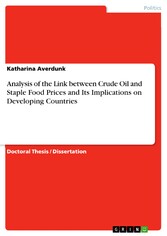Suchen und Finden
Analysis of the Link between Crude Oil and Staple Food Prices and Its Implications on Developing Countries
Mehr zum Inhalt

Analysis of the Link between Crude Oil and Staple Food Prices and Its Implications on Developing Countries
Doctoral Thesis / Dissertation from the year 2010 in the subject Politics - International Politics - Topic: Globalization, Political Economics, grade: 1,3, Carl von Ossietzky University of Oldenburg (Institut für Ökologische Ökonomie), language: English, abstract: Food prices - particularly prices of agricultural commodities used as a feedstock for biofuel production - have reached record highs in 2008. Within a period of slightly more than two years prices for staple food such as corn, soy, wheat, and vegetable oils have more than doubled. This price acceleration occurred at a time of surging crude oil prices and a rapid expansion of biofuel production, which relied nearly exclusively on feedstock from food crops. Consequently, the market development has triggered a controversial debate on the question whether the increase of agricultural prices in line with crude oil prices is a mere coincidence, due to stock market speculation, or result of a lasting integration of the agricultural and the energy sector. In the light of these uncertainties on an issue that could have a strong impact on global producers and consumers of food - particularly those in developing countries - the objective of this study is to analyse under which conditions agricultural commodity and crude oil markets could be linked in the future and in how far an integration of markets would affect developing countries. The dissertation is divided into three parts: Part I analyses under which conditions prices in different commodities markets in general follow the same trend. Part II investigates whether a similar co-movement of prices is technically possible in food and crude oil markets, while Part III focuses on potential effects of such a co-movement of prices on developing countries.
Alle Preise verstehen sich inklusive der gesetzlichen MwSt.







